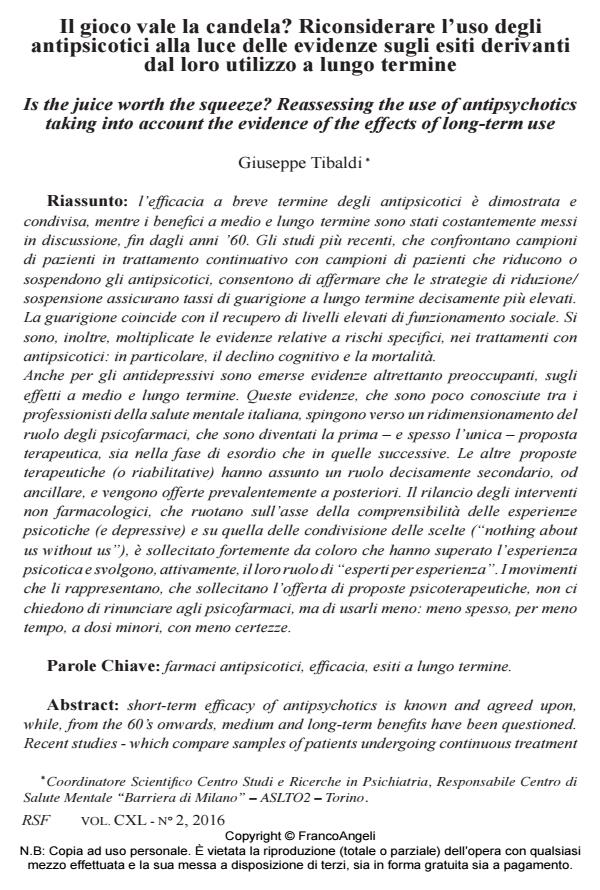Is the juice worth the squeeze? Reassessing the use of antipsychotics taking into account the evidence of the effects of long-term use
Journal title RIVISTA SPERIMENTALE DI FRENIATRIA
Author/s Giuseppe Tibaldi
Publishing Year 2016 Issue 2016/2
Language Italian Pages 21 P. 43-63 File size 223 KB
DOI 10.3280/RSF2016-002004
DOI is like a bar code for intellectual property: to have more infomation
click here
Below, you can see the article first page
If you want to buy this article in PDF format, you can do it, following the instructions to buy download credits

FrancoAngeli is member of Publishers International Linking Association, Inc (PILA), a not-for-profit association which run the CrossRef service enabling links to and from online scholarly content.
Short-term efficacy of antipsychotics is known and agreed upon, while, from the 60’s onwards, medium and long-term benefits have been questioned. Recent studies - which compare samples of patients undergoing continuous treatment with patients on reduced, or suspended, antipsychotic medications - highlight that strategies of reduced or suspended antipsychotic medications present significantly higher long-term recovery rates. Recovery consists in regaining high levels of social functioning. Furthermore, there is growing evidence on specific risks caused by antipsychotic treatments: i.e. cognitive decline and mortality. With antidepressants equally alarming evidence has emerged regarding medium and long-term effects. These evidences, little known among Italian mental health professionals, should bring about a reduction in the role played by psychiatric drugs, currently the primary - and often the only - therapeutic offer at onset, or during the subsequent phases of the illness. Nowadays, other therapeutic (or rehabilitative) proposals play a lesser, or subservient role, usually offered later on in the treatment program. Persons who have experienced a psychotic episode and play an active role as "experts by experience" request strongly the use of non-pharmacological interventions, based on the comprehension of the psychotic or depressive experiences, and on shared decision making ("nothing about us without us"). The movements of "experts by experience" require psychotherapeutic proposals, without asking to give up drugs, however they suggest reducing medications: i.e. less often, for less time, at lower doses, accompanied by fewer certainties.
Keywords: Antipsychotic drugs, effectiveness, long-term outcomes
- Il contributo dei servizi ai processi di cronicizzazione. Quali ombre del manicomio gravano ancora sulle pratiche della "nostra" psichiatria di comunità? Giuseppe Tibaldi, in RIVISTA SPERIMENTALE DI FRENIATRIA 3/2018 pp.9
DOI: 10.3280/RSF2018-003002 - Hanno ucciso l’Uomo Ragno. Nascita, splendore, declino di una fase mitica della psicopatologia clinica e della psicoterapia. C’è ancora margine per una loro dignità scientifica? Una proposta connessionista complessa Miriam Gandolfi, in Ricerca Psicoanalitica /2022
DOI: 10.4081/rp.2022.608
Giuseppe Tibaldi, Il gioco vale la candela? Riconsiderare l’uso degli antipsicotici alla luce delle evidenze sugli esiti derivanti dal loro utilizzo a lungo termine in "RIVISTA SPERIMENTALE DI FRENIATRIA" 2/2016, pp 43-63, DOI: 10.3280/RSF2016-002004